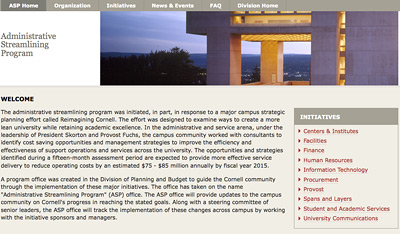Administrative Streamlining Program office furthers efficiency initiatives
By Susan Kelley

The university is taking the next steps in its streamlining process to rethink its administrative services, achieving cost savings goals through program and project redesign. The effort is part of the "Reimagining Cornell" initiative and is expected to save the university up to $85 million annually by 2015.
To reflect that progress, the Administrative Streamlining Program (ASP) office, formerly called the Initiatives Coordination Office, has launched a new website and will host a series of public forums that starts Oct. 26.
"The change provides a more descriptive name for the work we are doing," said Elmira Mangum, vice president for planning and budget, who oversees the ASP office. "We want the campus to know that we are not just cutting budgets, but working to provide more efficient and effective service delivery that is institutional in nature and includes the entire Cornell community."
The website, http://asp.dpb.cornell.edu, which is accessible with a Cornell NetID, contains a description, timeline and anticipated savings for each initiative, with graphs that depict a project schedule and anticipated savings for the ASP office as a whole. An organization page lists steering committee members as well as each initiative's sponsors and managers. A news and events page currently provides information about the upcoming forums, and a reports and updates page will provide new information as it becomes available.
The ASP office's 10 initiatives are: centers and institutes, facilities, finance, human resources, information technology, procurement, Office of the Provost, "spans and layers," student and academic services, and university communications. Along with a steering committee of senior leaders, the ASP office will track implementation of these changes by working with initiative sponsors and managers.
The first forum will cover the initiatives involving human resources and spans (how many people a manager supervises) and layers (the tiers between the president and a division's lowest-ranking employee). The human resources initiative will implement a new human resources/payroll management system, create an "on-boarding" center to manage the experience of new staff and faculty, and consolidate central shared services. The spans and layers initiative analyzes administrative overhead and reaps savings by reducing spans and layers.
Get Cornell news delivered right to your inbox.
Subscribe